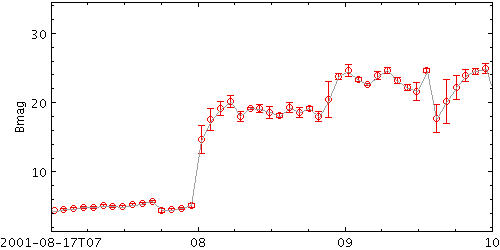
yerror
Plots symmetric or asymmetric error bars in the Y direction.
Usage Overview:
layerN=yerror errorbarN=none|lines|capped_lines|caps|arrows
thickN=<int-value> shadingN=flat <shade-paramsN>
tN=<time-expr> ttypeN=DecYear|MJD|JD|Unix|Iso8601
yN=<num-expr> yerrhiN=<num-expr> yerrloN=<num-expr>
inN=<table> ifmtN=<in-format> istreamN=true|false icmdN=<cmds>
All the parameters listed here
affect only the relevant layer,
identified by the suffix
N.
Example:

stilts plot2time in=ACE_data.vot t=epoch y=Bmag
layer1=yerror yerrhi1=sigma_B errorbar1=capped_lines
layer2=mark shape2=open_circle size2=3
layer3=line color3=a0a0a0
tmin=2001-08-17T07 tmax=2001-08-17T10 ypix=250
errorbarN = none|lines|capped_lines|caps|arrows (MultiPointShape)
The available options are:
none
lines
capped_lines
caps
arrows
[Default: lines]
icmdN = <cmds> (ProcessingStep[])
inN.
The value of this parameter is one or more of the filter
commands described in Section 6.1.
If more than one is given, they must be separated by
semicolon characters (";").
This parameter can be repeated multiple times on the same
command line to build up a list of processing steps.
The sequence of commands given in this way
defines the processing pipeline which is performed on the table.
Commands may alternatively be supplied in an external file,
by using the indirection character '@'.
Thus a value of "@filename"
causes the file filename to be read for a list
of filter commands to execute. The commands in the file
may be separated by newline characters and/or semicolons,
and lines which are blank or which start with a
'#' character are ignored.
A backslash character '\' at the end of a line
joins it with the following line.
ifmtN = <in-format> (String)
inN.
The known formats are listed in Section 5.1.1.
This flag can be used if you know what format your
table is in.
If it has the special value
(auto) (the default),
then an attempt will be
made to detect the format of the table automatically.
This cannot always be done correctly however, in which case
the program will exit with an error explaining which
formats were attempted.
This parameter is ignored for scheme-specified tables.
[Default: (auto)]
inN = <table> (StarTable)
-",
meaning standard input.
In this case the input format must be given explicitly
using the ifmtN
parameter.
Note that not all formats can be streamed in this way.:<scheme-name>:<scheme-args>.<" character at the start,
or a "|" character at the end
("<syscmd" or
"syscmd|").
This executes the given pipeline and reads from its
standard output.
This will probably only work on unix-like systems.istreamN = true|false (Boolean)
inN parameter
will be read as a stream.
It is necessary to give the
ifmtN parameter
in this case.
Depending on the required operations and processing mode,
this may cause the read to fail (sometimes it is necessary
to read the table more than once).
It is not normally necessary to set this flag;
in most cases the data will be streamed automatically
if that is the best thing to do.
However it can sometimes result in less resource usage when
processing large files in certain formats (such as VOTable).
This parameter is ignored for scheme-specified tables.
[Default: false]
shadingN = flat <shade-paramsN> (ShapeMode)
[Default: flat]
tN = <time-expr> (String)
The value is a Time value algebraic expression based on column names as described in Section 10.
thickN = <int-value> (Integer)
[Default: 0]
ttypeN = DecYear|MJD|JD|Unix|Iso8601 (TimeMapper)
tN is supplied.
Options are:
DecYear: Years since 0 ADMJD: Modified Julian DateJD: Julian DayUnix: Seconds since midnight 1 Jan 1970Iso8601: ISO 8601 stringtN value.
yN = <num-expr> (String)
The value is a numeric algebraic expression based on column names as described in Section 10.
yerrhiN = <num-expr> (String)
The value is a numeric algebraic expression based on column names as described in Section 10.
yerrloN = <num-expr> (String)
The value is a numeric algebraic expression based on column names as described in Section 10.